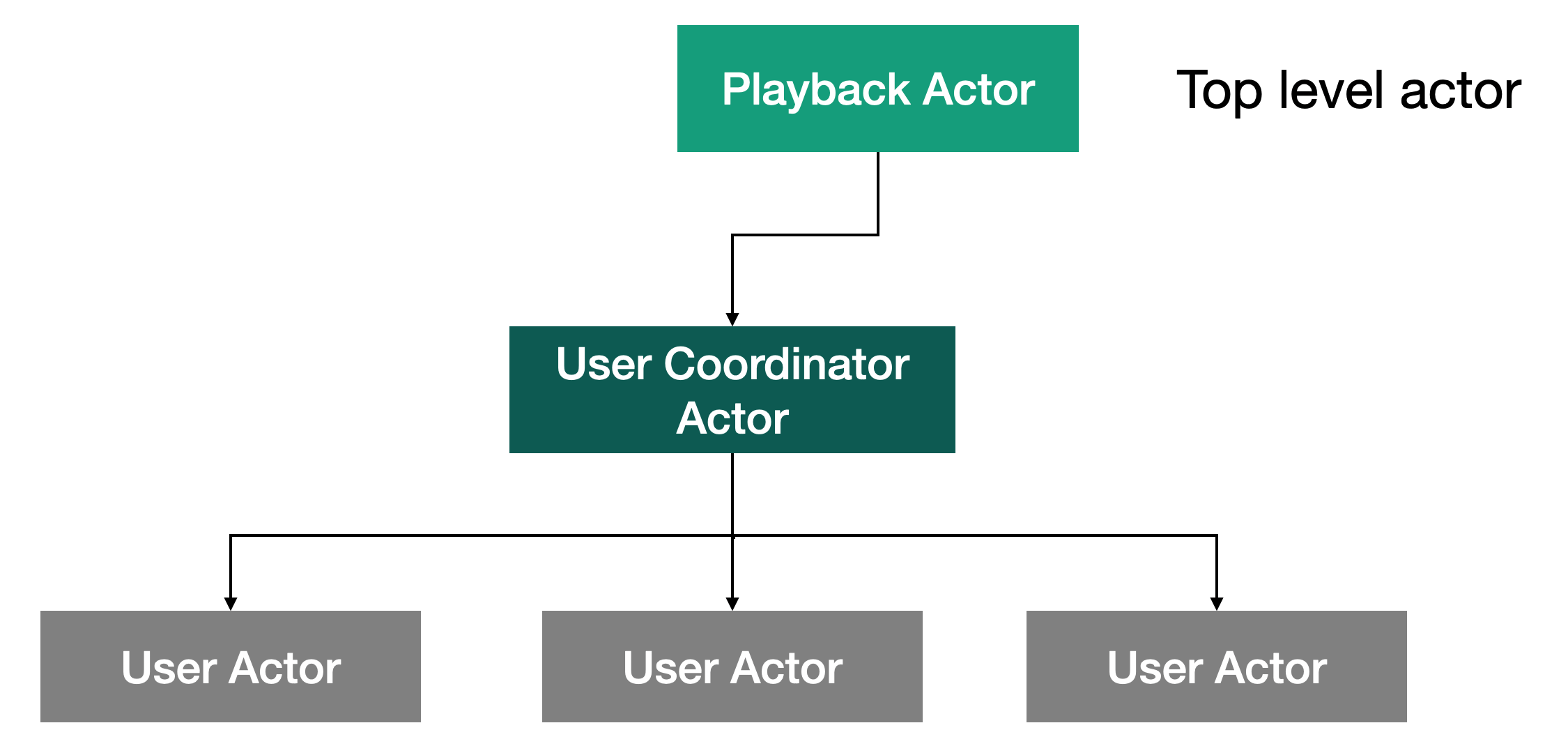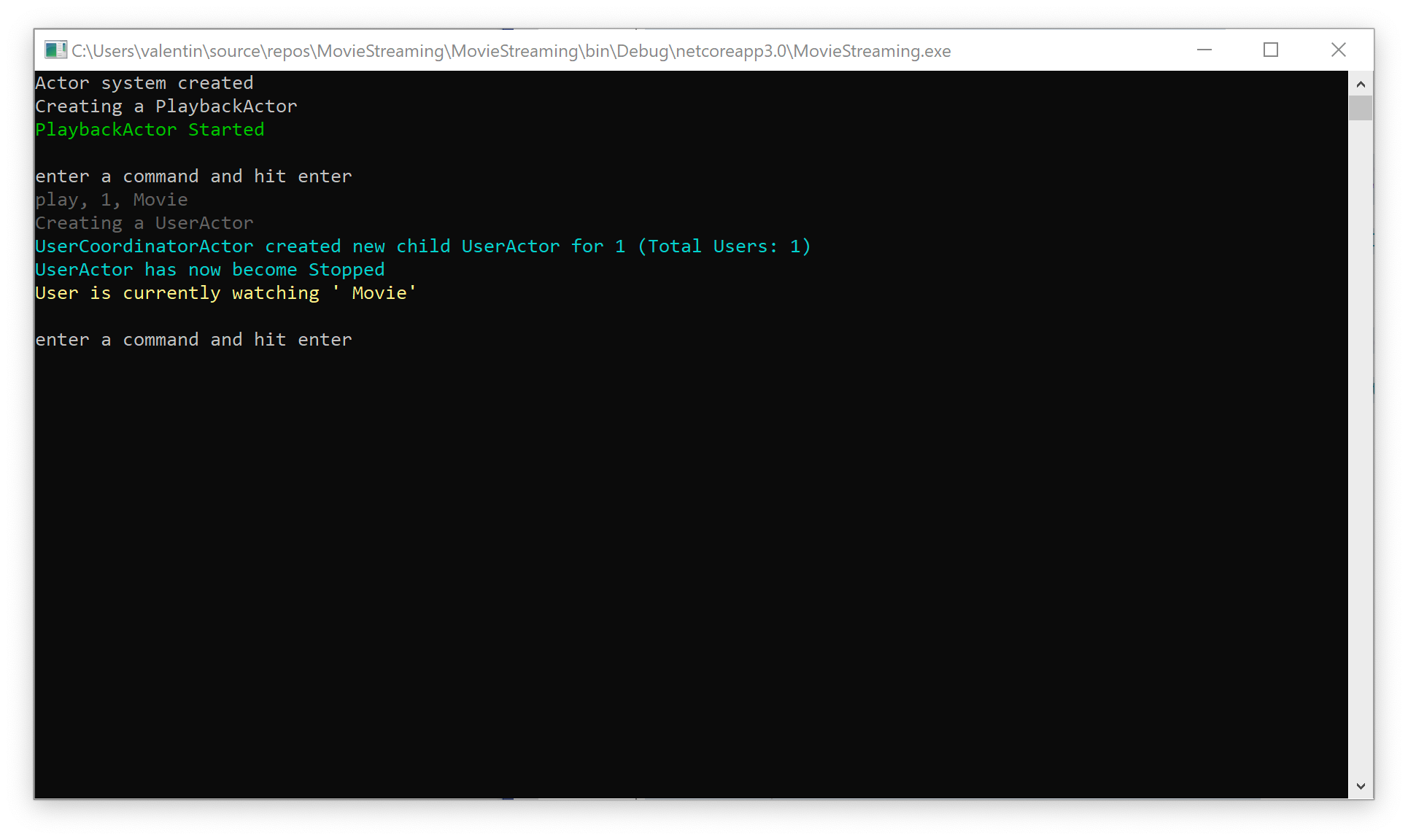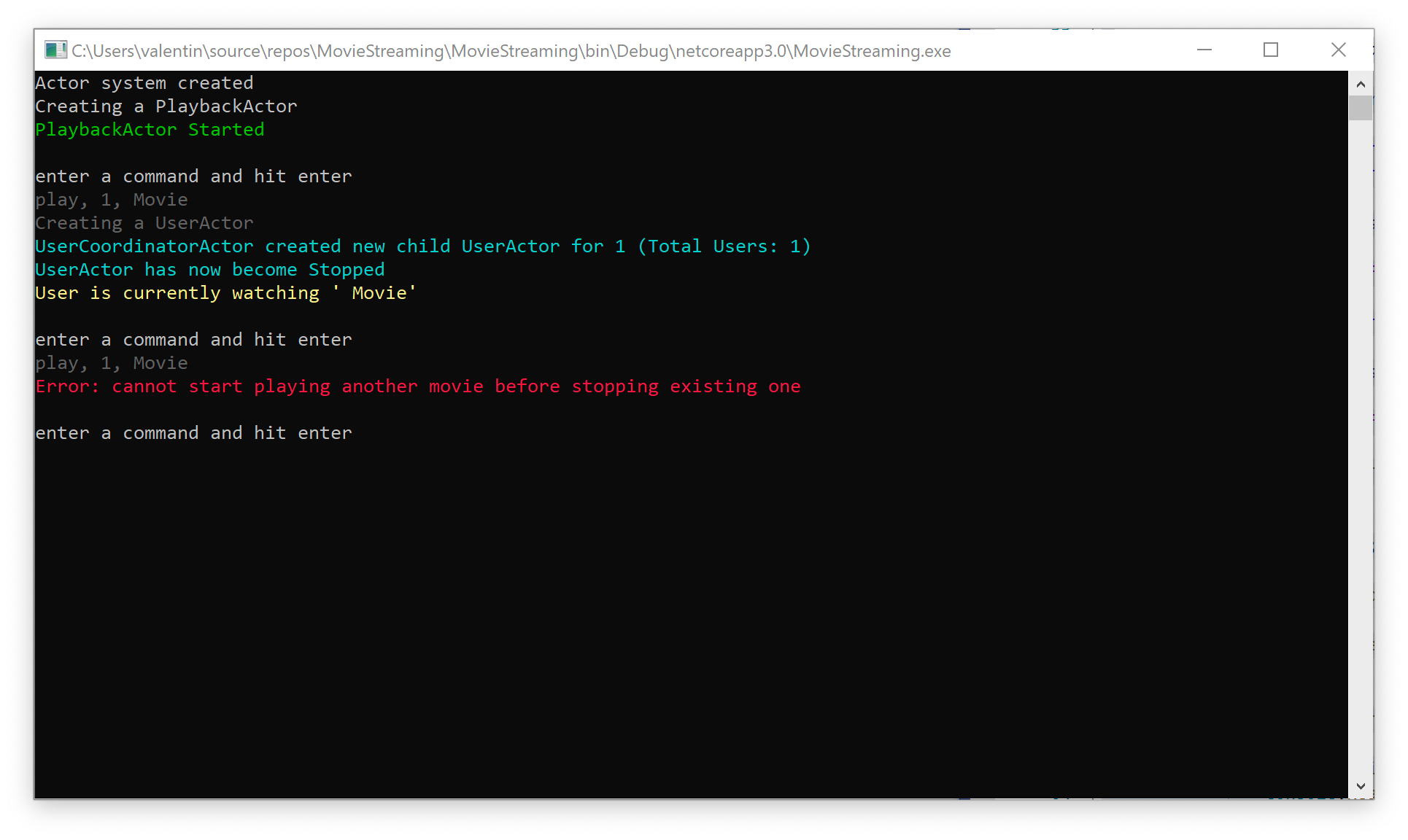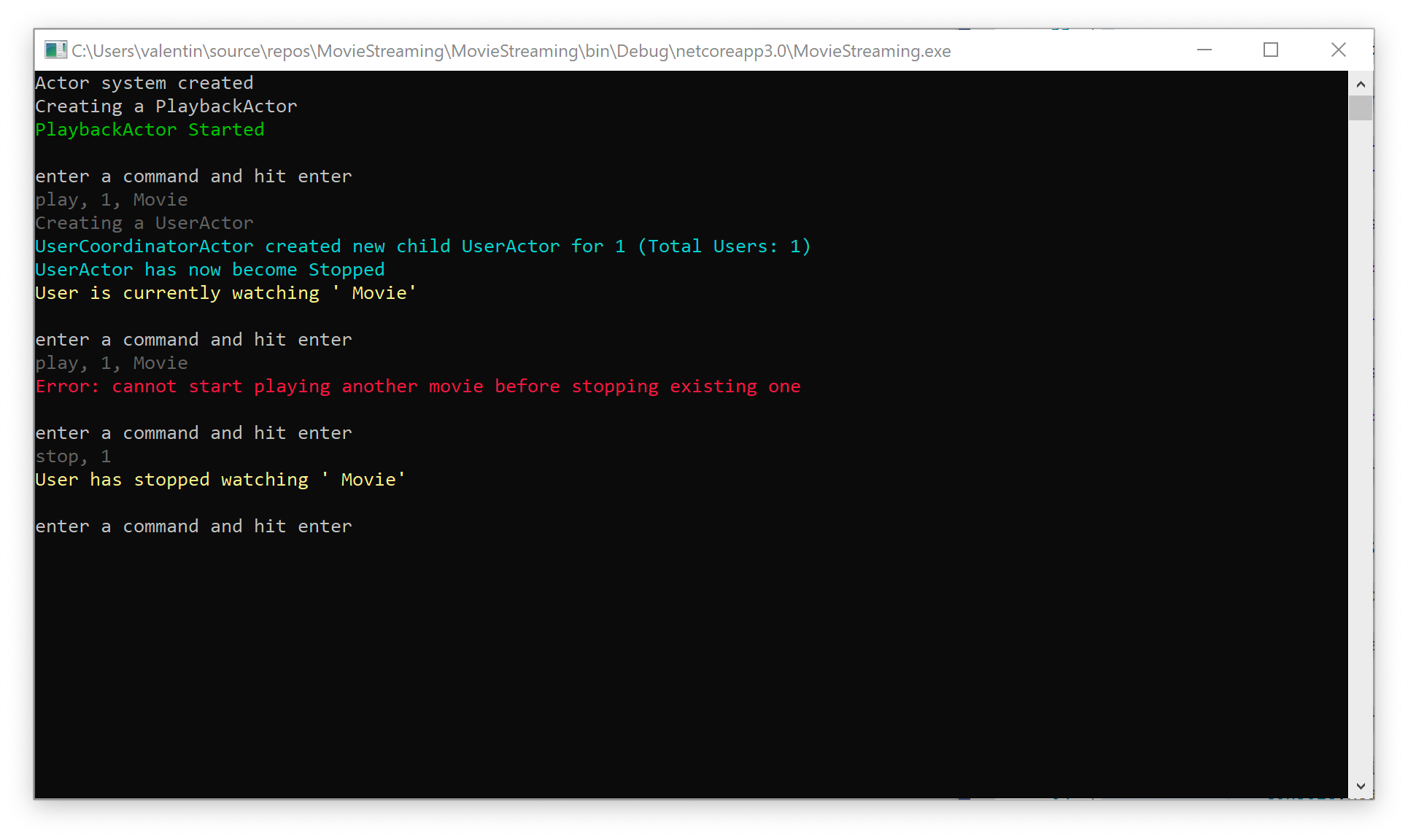Lesson 4: Creating UserCoordinatorActor.
So, let’s begin creating the final architecture for our application. In this lesson, we will add UserCoordinatorActor() to our actor hierarchy. This actor will be responsible for creating child actors and sending them various messages.

First of all, we will need to do a little preparatory work. First, we need to add the UserId to the StopMovieMessage() message.
public class StopMovieMessage
{
public int UserId { get; private set; }
public StopMovieMessage(int userId)
{
UserId = userId;
}
}
Now let’s add UserId to the UserActor() class.
public class UserActor : IActor
{
private int _id;
public UserActor(int id)
{
_id = id;
}
}
Next, we need to add a couple of messages to the Messages folder. The first message will be called RequestActorPid(). And it will will be used to request the Pid of the desired actor.
public class RequestActorPid
{
}
The second message called ResponseActorPid() is used to respond to RequestActorPid() and contains the Pid of the desired actor.
public class ResponseActorPid
{
public PID Pid { get; }
public ResponseActorPid(PID pid)
{
Pid = pid;
}
}
Now we can start creating the UserCoordinatorActor() class. Let’s go to the Actors folder and add the class UserCoordinatorActor().
public class UserCoordinatorActor : IActor
{
private readonly Dictionary<int, PID> _users = new Dictionary<int, PID>();
public Task ReceiveAsync(IContext context)
{
switch (context.Message)
{
case PlayMovieMessage msg:
ProcessPlayMovieMessage(context, msg);
break;
case StopMovieMessage msg:
ProcessStopMovieMessage(context, msg);
break;
}
return Task.CompletedTask;
}
private void ProcessPlayMovieMessage(IContext context, PlayMovieMessage msg)
{
CreateChildUserIfNotExists(context, msg.UserId);
var childActorRef = _users[msg.UserId];
context.Send(childActorRef, msg);
}
private void CreateChildUserIfNotExists(IContext context, int userId)
{
if (!_users.ContainsKey(userId))
{
var props = Props.FromProducer(() => new UserActor(userId));
var pid = context.SpawnNamed(props, $"User{userId}");
_users.Add(userId, pid);
ColorConsole.WriteLineCyan($"UserCoordinatorActor created new child UserActor for {userId} (Total Users: {_users.Count})");
}
}
private void ProcessStopMovieMessage(IContext context, StopMovieMessage msg)
{
CreateChildUserIfNotExists(context, msg.UserId);
var childActorRef = _users[msg.UserId];
context.Send(childActorRef, msg);
}
}
As you can see, this actor checks that a suitable child actor exists. If the actor does not exist, our actor creates it and then adds a link to it in the `_users’ dictionary. Then using this dictionary, it extracts a link to the appropriate actor and sends it a message.
Now we need to make a change to the PlaybackActor() so that it can create an instance of the UserCoordinatorActor() class and save a link to it.

To do this, make the necessary changes to the ProcessStartedMessage method so that it creates a child actor UserCoordinatorActor() and saves the link immediately after it is created.
public class PlaybackActor : IActor
{
private PID _userCoordinatorActorRef;
private void ProcessStartedMessage(IContext context, Started msg)
{
ColorConsole.WriteLineGreen("PlaybackActor Started");
var props = Props.FromProducer(() => new UserCoordinatorActor());
_userCoordinatorActorRef = context.Spawn(props);
}
And also add the RequestActorPid handler to PlaybackActor().
public Task ReceiveAsync(IContext context)
{
switch (context.Message)
{
case Started msg:
ProcessStartedMessage(context, msg);
break;
case PlayMovieMessage msg:
ProcessPlayMovieMessage(msg);
break;
case Recoverable msg:
ProcessRecoverableMessage(context, msg);
break;
case Stopping msg:
ProcessStoppingMessage(msg);
break;
case RequestActorPidMessage msg:
ProcessRequestActorPidMessage(context, msg);
break;
}
return Task.CompletedTask;
}
So that ‘PlaybackActor ()’ can send a link to its child actor when requested.
private void ProcessRequestActorPidMessage(IContext context, RequestActorPidMessage msg)
{
context.Respond(new ResponseActorPidMessage(_userCoordinatorActorRef));
}
Now, all we have to do is add the ability to manage our app using commands from the console. To do this, let’s open our Program() class and make the necessary changes.
class Program
{
static async Task Main(string[] args)
{
var system = new ActorSystem();
Console.WriteLine("Actor system created");
var props = Props.FromProducer(() => new PlaybackActor());
var playbackPid = system.Root.Spawn(props);
var actorPidMessage = await system.Root.RequestAsync<ResponseActorPidMessage>(playbackPid, new RequestActorPidMessage());
var userCoordinatorActorPid = actorPidMessage.Pid;
do
{
ShortPause();
Console.WriteLine();
Console.ForegroundColor = ConsoleColor.DarkGray;
ColorConsole.WriteLineGray("enter a command and hit enter");
var command = Console.ReadLine();
if (command != null)
{
if (command.StartsWith("play"))
{
var userId = int.Parse(command.Split(',')[1]);
var movieTitle = command.Split(',')[2];
system.Root.Send(userCoordinatorActorPid, new PlayMovieMessage(movieTitle, userId));
}
else if (command.StartsWith("stop"))
{
var userId = int.Parse(command.Split(',')[1]);
system.Root.Send(userCoordinatorActorPid, new StopMovieMessage(userId));
}
else if (command == "exit")
{
Terminate();
}
}
} while (true);
static void ShortPause()
{
Thread.Sleep(250);
}
static void Terminate()
{
Console.WriteLine("Actor system shutdown");
Console.ReadKey();
Environment.Exit(1);
}
}
}
As you can see, commands are read from the console and converted to appropriate messages, and next sent to the UserCoordinatorActor() actor.
Let’s run our project and see what happened.

When you enter the command “play,1, Movie” the movie starts playing.

When you re-enter the same command, you will receive an error message since the movie playback is already running.
If we want to stop it playing, we should type “stop”.
